World of Warcraft Updated Hands-On Impressions - The Horde
We rejoin the ongoing beta test for this upcoming online game by playing as the Horde--an unholy alliance of orcs, trolls, tauren, and undead.
Unless you've recently been out of touch with the gaming world, there's a good chance that you've heard of World of Warcraft by now. The upcoming massively multiplayer game will let you play as a character in a persistent world based on Blizzard's popular Warcraft setting--a setting where noble human knights and staunch dwarf priests square off against fierce orc shaman and undead warriors. As with other such offerings, World of Warcraft is a role-playing game that lets you both create and adventure as a single character in a persistent world while simultaneously allowing you to gain experience levels, treasure, and better weapons and armor by fighting monsters and completing quests. As we've seen previously, World of Warcraft's character classes currently differentiate themselves from one another by relying--to different degrees--on different types of armor, weapons (like swords and axes), and magic spells (which are powered by magical energy, or "mana").
The game is currently in a beta test state, and Blizzard has recently introduced several new features, like the new druid character class (and the re-enabled shaman character class, which had been previously available during earlier test phases). The latest update also includes the Horde races, which consist of the savage, green-skinned, orcs; the crafty, sinuous trolls; the hulking, hoofed, and horned tauren; and the evil undead. Luckily, we're including new details on all these new additions.
On the far eastern side of Kalimdor lies Durotar, the home of the orc and troll races. Durotar is just as desolate and barren as the snowy residence of the dwarves and gnomes on the opposing continent, but Durotar, instead, is a dry, dusty, scorched wasteland lined with massive rock formations. Dry riverbeds make up the primary paths and roads for safe travel. At this point in time, when you create a new orc or troll character, you start your travels just outside of an area known as "The Den," which is a congregation point for the two races that consists of a large cave full of trainers, weaponsmiths, and other merchants. Follow the dry riverbeds away from this area, and you'll eventually encounter Razor Hill, home of the orcs, and Sen'jin Village, home of the trolls. Both towns are crudely built with lots of thick lumber tied together by rope, and most buildings also feature straw-laden roofs. Neither the orcs nor the trolls are particularly big on iconic imagery, save for the few banners that are hung throughout certain buildings that bear the flags of each race. Orcs may be warlocks, warriors, rogues, or shaman, while trolls may be mages, warriors, rogues, shaman, or priests. Both races will also eventually be able to join the not-yet-implemented hunter class (nature-themed warriors who can tame wild animals).
The tauren, who are essentially giant cow-people, reside in Mulgore on the continent of Kalimdor. Their home area features an impressive landscape with rolling hills and plains, few trees, and a vast blue sky. The tauren starting area lies near other settlements, like Bloodhoof, which is a medium-sized town that features trainers and a number of new quests. Additionally, the main tauren city of Thunder Bluff resides near Bloodhoof. Thunder Bluff is quite a sight because it's situated on top of four mesas that are connected by bridges; from Thunder Bluff, players are presented with scenic, panoramic views of the plains. Like big cities in other lands, Thunder Bluff has a large number of trainers and vendors. Like in Warcraft III, tauren architecture and clothing draw inspiration from Native American culture. The villages consist of tepees that are bordered by totem poles, and they are ruled by chieftains. Tauren are very mindful of nature, and many of their quests revolve around restoring the balance of nature and driving out invaders. The tauren may be hunters, warriors, shaman, and druids, and at level 40, they apparently gain the high-level ability to plain-stride, which involves exceptionally fast travel. (Currently, characters may only reach level 35 in the beta.)
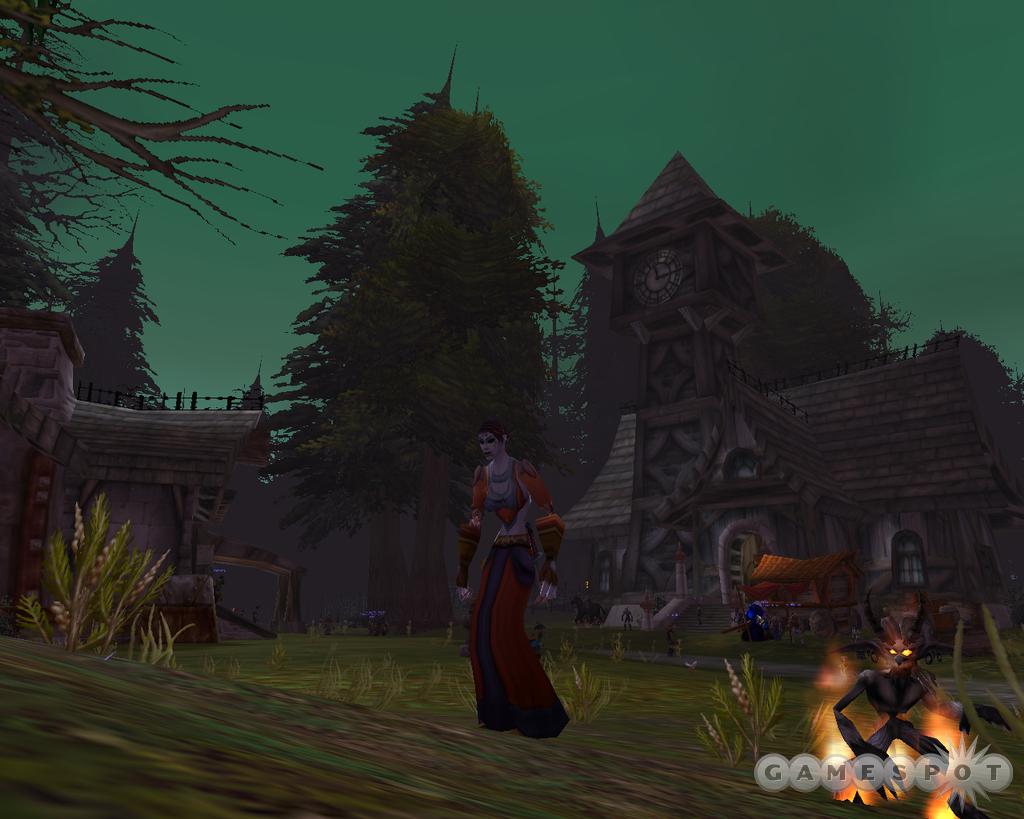
We also took the opportunity to explore the native undead lands of Tirisfal Glades. Having played through the previous phase of the beta test with the Alliance races (humans, night elves, dwarves, and gnomes), we were surprised to see that much of the architecture in the Tirisfal Glades area was highly reminiscent of the Elwynn Forest area--though, admittedly, it was much more run-down. But this does make sense, since the undead were once humans themselves. However, this architecture--with walking skeletons and shambling zombies that roam the dreary, gray countryside--definitely has a look of its own. The Undercity was the first major city we encountered on our adventures. This sizable underground area has a much more sinister look to it than the rolling countryside that surrounds it, since it presents bulky blue mutilated guards at major entrances, and a sickly green flow of liquid courses through the city, much like in the necropolis structure from Warcraft III. Undead characters seem to look appropriately grotesque and can become warriors, rogues, priests, mages, and warlocks. They currently possess powerful immunities to certain types of magical attacks, in addition to possessing the ability to breathe underwater.
My Life for the Horde
Our time with the beta allowed us to try out World of Warcraft's character classes, both new and old. For instance, the druid is a versatile class that can wear cloth and leather armor, fight decently in battle, and cast powerful magic spells. These include direct-damage spells, like "wrath," which allows you to attack from a distance; "entangling roots," which hold an enemy in place (while continuously damaging him or her as well); and "moonfire," which deals damage over time. Druids also have beneficial spells, like "regrowth," which heals a player over time, and "mark of the wild," which provides bonus armor. And later on, druids can even transform into powerful beasts.
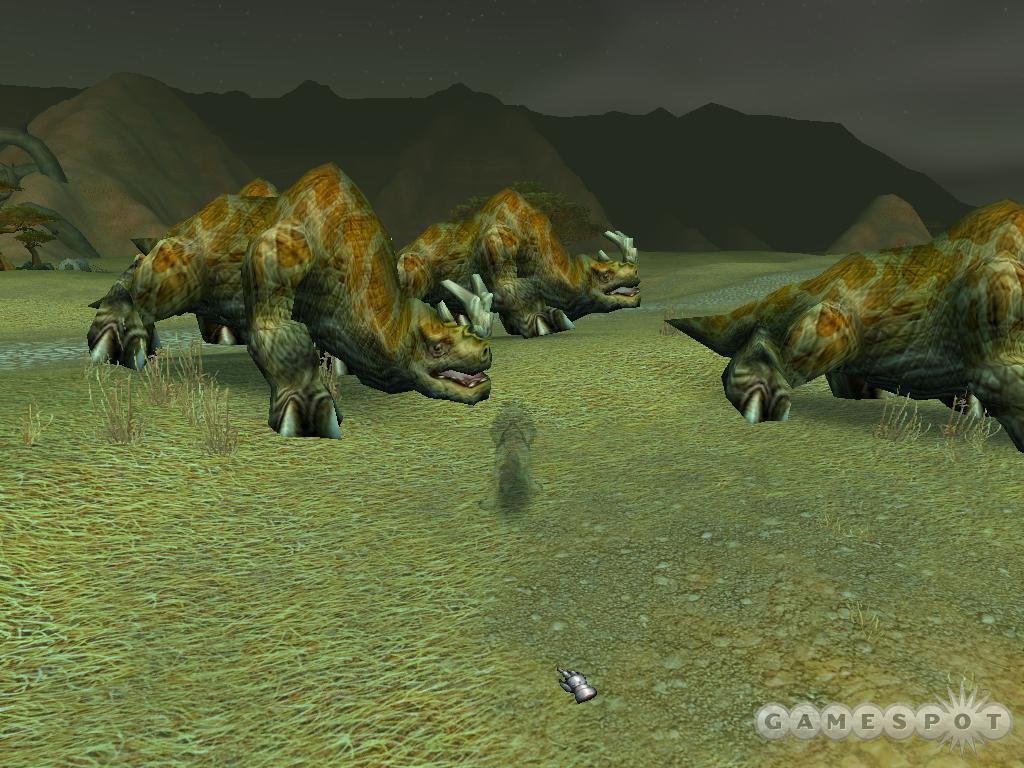
Currently, druids earn their first transformation at level 10, which is bear form. This is followed by aquatic form at level 16, cat form at level 20, and travel form at level 30. The aquatic form lets you both swim fast and breathe underwater, while the travel form presumably lets your run faster. The other two forms, bear and cat, actually resemble the warrior and rogue classes, respectively. The bear form presents a "rage meter" (which replaces mana) that functions exactly like the warrior's. When you deal and sustain damage, you build rage, which, in turn, lets you use more-powerful attacking abilities. The cat form has an energy bar (again, replacing mana) that functions like the rogue's. You spend energy using moves that build "combo points," which you can then use to unleash a powerful series of attacks. Still, druids seem to be jacks-of-all-trades and masters-of-none. As a result, they aren't as skilled as priests, warriors, or rogues in healing, combat, or stealth, respectively.
We also tried out the shaman class, which also seems like a well-rounded character class. The shaman can wear leather armor and may carry a small buckler shield, along with maces and staves (at this point in time, shamans may also later opt to learn about wielding axes and daggers by purchasing the skills necessary to do so). The shaman's spellbook includes an array of damaging spells, weapon enhancements, one healing spell, and even one resurrection spell. As a result, shamans, like druids, can fill in as surrogate priests (when no priests are available). A shaman may also learn to change shape into a ghost wolf, which has a much faster movement speed and a decent attack power but lacks spells.
What really sets shamans apart from the rest of the classes is the totem--a magic ability that lets them summon a stationary "totem," which gives off a special effect within a limited radius. These totems involve earth, water, fire, and air. Earth totems can provide "stoneskin," an armor enhancement, or "earthbind," which reduces enemy movement speed. The fire totem spells include "searing," which does light damage over time to all enemies within a specific radius, and "flametongue," which imparts additional fire damage to the shaman's weapon and to those of his party members. However, totems do have some weaknesses. For instance, they can be destroyed in battle; they have only a limited radius; and only certain effects stack with each other. This means that you can have both an earth-based stoneskin totem and a water-based "healing stream" totem in play at the same time, but casting an earth-based earthbind totem will cancel out your original stoneskin totem. Regardless, shamans are useful in parties because of their healing abilities and totems. However, the versatile nature of their weapons, armor, and magic also make them very viable for solo adventuring, since they represent such a very well-rounded class (at least at this stage in the beta).
We also revisited the priest class, which was significantly changed in the game by the removal of its "sleep" spell, which was a powerful sorcery that would temporarily incapacitate enemies and allow priests to perform "crowd control" (thus immobilizing extra foes until you or your group had time to deal with them). Sleep has now moved to the mage class, so priests are now more-focused on their greatest strengths, which include the abilities to both heal and shield themselves and other characters from damage. Priests have two main types of spells: holy magic and shadow magic. Holy spells include those involving healing, shields, "stat buffs," (spells that increase their target's ability scores, like strength and stamina), and holy attacks, while shadow spells range from those that damage to mind-control spells that let you affect enemies and how aggressively they'll attack you and your friends. One of the priest's most useful spells is "holy word: shield," which completely protects a character from damage (either for a limited time or until it has absorbed a certain amount of damage). It's thanks to this spell that the cloth-wearing priests are able to fight alone as effectively as they do, though it's also a great way to make monsters angry at you. Fortunately, priests now have a new spell, named "fade," which decreases enemies' animosity toward you so that they can focus their attentions on more-heavily armored warriors.

Priests wield a mace by default (though they can become proficient in other weapon classes, such as staves), but they have no special melee skills to speak of. They are dependent on their damage-absorbing shield for protection, but from behind that shield, priests can cast spells without interruption, enabling them to heal, throw out a strong offensive spell, or attack in safety. For such a lightly armored, magic-focused class, they do very well toe-to-toe with enemies. In a group, priests often take the role of the healer, and they have a good number of healing spells of varying effects and costs that can be tailored to the particular adventuring circumstances. A group with a priest often has very little "downtime," or time that the group must spend sitting and resting to recover lost health and mana. While priests aren't able to control crowds anymore, they remain a solid and very viable class.
Say Hello to My Little Friend
We also took the opportunity to play as one of World of Warcraft's undead warlocks. Warlocks rely almost entirely on magic, since they can otherwise use only small, one-handed weapons, like daggers or wands, and cloth armor. However, warlocks possess powerful offense-oriented magic, with a good variety of ranged spells, thus making them valuable for drawing enemies toward you from a distance so that you can potentially get in several hits before the enemy even has a chance to counter. Warlocks also possess the ability to summon creatures to aid them during combat. We learned early on how to summon a fiery imp, over whom we had a fair amount of control. We could command it to attack specific enemies, or we could tell it to focus on one enemy and then have it act as bait for this enemy. We could even specify how aggressive the imp was toward nearby creatures. Having a pet like the imp seems to create some real combat options for a class that would otherwise be pretty straightforward.
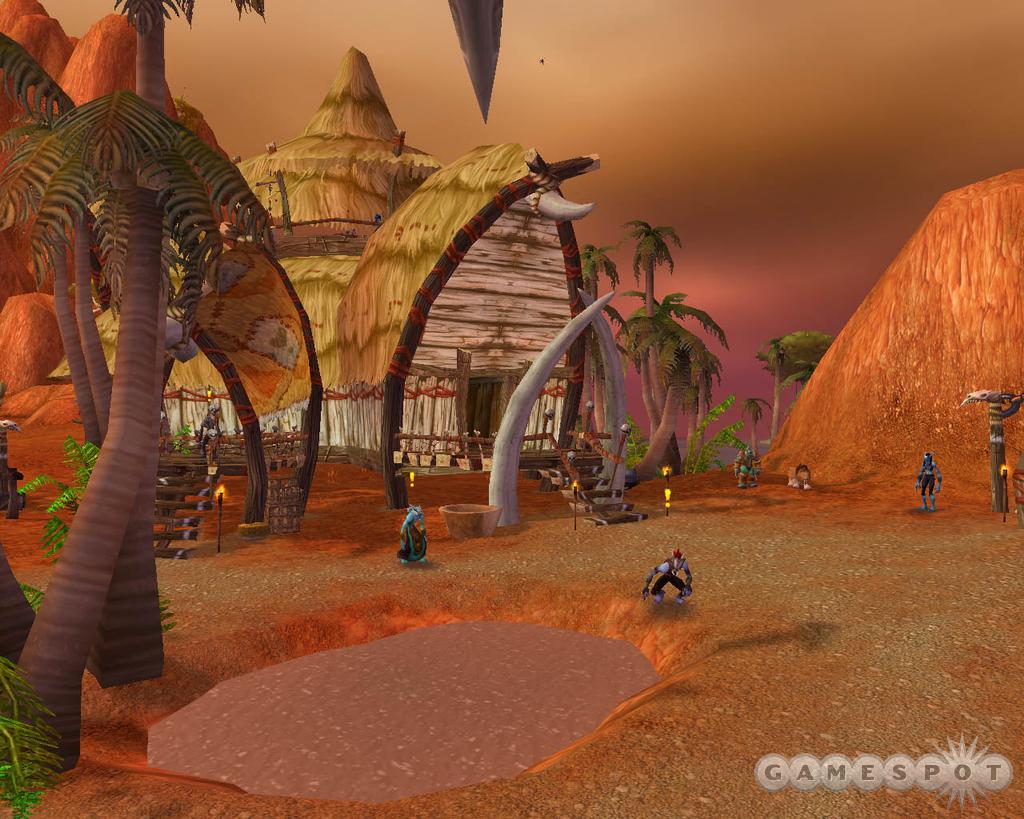
The game's skill system has also been changed in the latest update. In previous versions, your characters would gain "skill points" when they gained levels. You could use these points to purchase proficiency levels in different trade skills, like cooking, alchemy, or skinning. In the most recent update, you, instead, gain skill points by fighting enemies. This dramatically increases the amount of skill points you'll have available, but the beta has also drastically increased the amount of skill points you must invest to become a crafting journeyman and master. In addition, you can currently use skill points to manually increase certain character statistics, like strength, intellect, or spirit. These bonuses were previously purchased using talent points, but the talent system is currently disabled. So, right now, we've found ourselves forced to carefully weigh improvements to our abilities against mastering leatherworking or alchemy.
Along with the aforementioned additions, Blizzard has introduced a new fatigue system. Basically, it gives well-rested players experience point bonuses. Conversely, if you play the game for hours on end, your characters will fatigue. While "well-rested," your characters gain a bonus of 200 percent. As characters become simply "rested," they gain only a 150 percent bonus. At normal levels, there are no bonuses. Continuing to grind your tired characters into the ground will cause two levels of experience penalties. There is a "fatigued" level, where you only get 50 percent experience, and, for players with a never-ending supply of caffeine, there is an "exhausted state," where you'll only get a quarter of the experience points you'd normally receive. So, you must rest up either by logging out or putting your character into an inn. You'll accumulate rest more quickly if you spend your character's offline hours in an inn, but the overall rest needed is dictated by how fatigued your character is.
Inns also give you a hearthstone, which lets you magically return to them. (Currently, you can use this ability only once an hour). Predictably, some players have cried foul at the new system, claiming it penalizes players who want to play marathon sessions. But, so far, the system seems to work pretty well to balance the game's different activities. Whether or not the rest system, along with most of the game's other systems and features, remains intact in the final version of the game, however, remains to be seen.
Not content with just our hearthstones, we found ourselves attempting to leave the realm of the Horde to Alliance territory. While World of Warcraft's player-versus-player (PvP) rules haven't been implemented yet, we couldn't help but try to bring some undead characters to Azeroth, the land of the living.
Eventually, Blizzard will make it possible for players of opposing factions to square off in mortal combat, although PvP will most likely be only through mutual consent. We weren't able to attack other players, but, to our delight, computer-controlled non-player characters that belonged to opposing races were fair game. Unfortunately, most areas were populated by high-level guards that kept wayward enemy players from terrorizing the populace. In fact, extremely high-level guards dispatched us easily on more than one occasion on our way to the human capital of Stormwind. Even now it's virtually impossible for a member of one faction to invade a capital city on the other side, since the guards are absurdly strong. How the PvP mechanics will unfold as they're rolled into the ongoing beta will be a topic of great interest for anyone following the game.
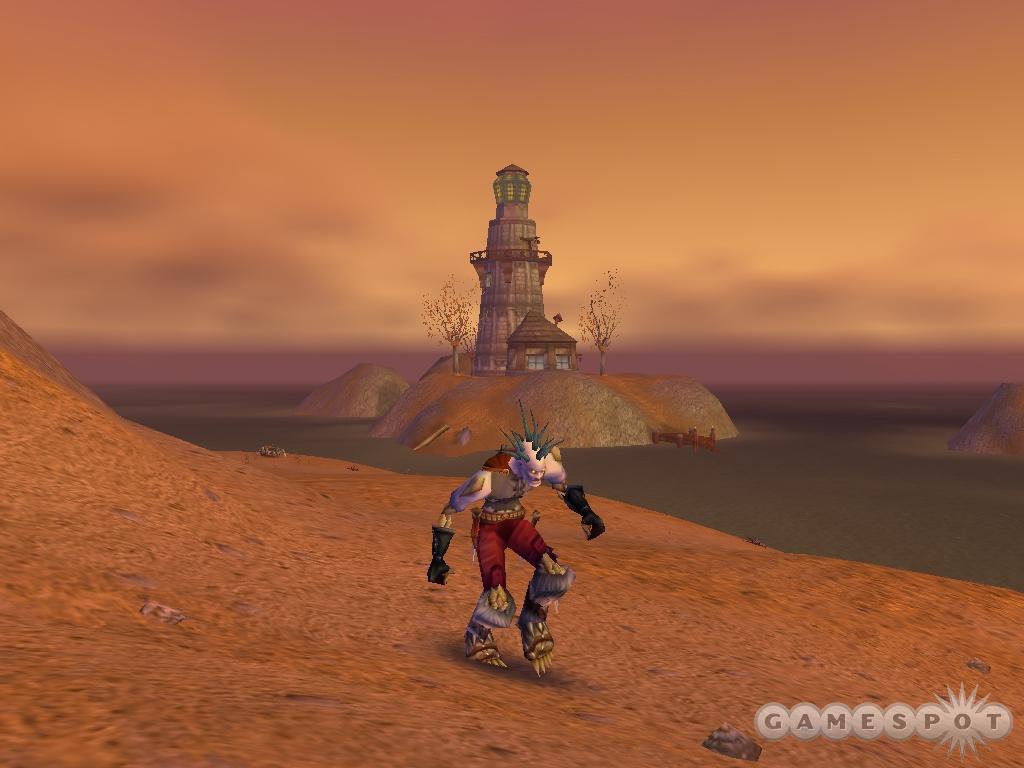
Blizzard is further differentiating the groups in World of Warcraft by the inclusion of unique languages for several of the races. You'll begin the game with a proficiency in one or two languages. So, for instance, undead characters can currently speak common and orcish. Presumably, you'll be able to learn other tongues as you progress in skill. When we ran into our first group of humans after invading Westfall, we tried to engage in conversation without any apparent understanding on the part of our living counterparts. We had no problem comprehending what they were saying, though, and after much shouting and waving of hands, we determined that--at least for now--undead characters actually start off speaking orcish. We then switched our active language to "common" and were able to strike up a real conversation, even politely offering to eat the brains of our human counterparts. As with all things in the beta, the language rules are still being finalized. So far, it looks like this system will create just one more interesting layer of complexity for those times when players pit characters of varying factions and regions against one another. In the meantime, we'll continue to keep you up-to-date on the World of Warcraft beta as it continues in the coming months.
Got a news tip or want to contact us directly? Email news@gamespot.com
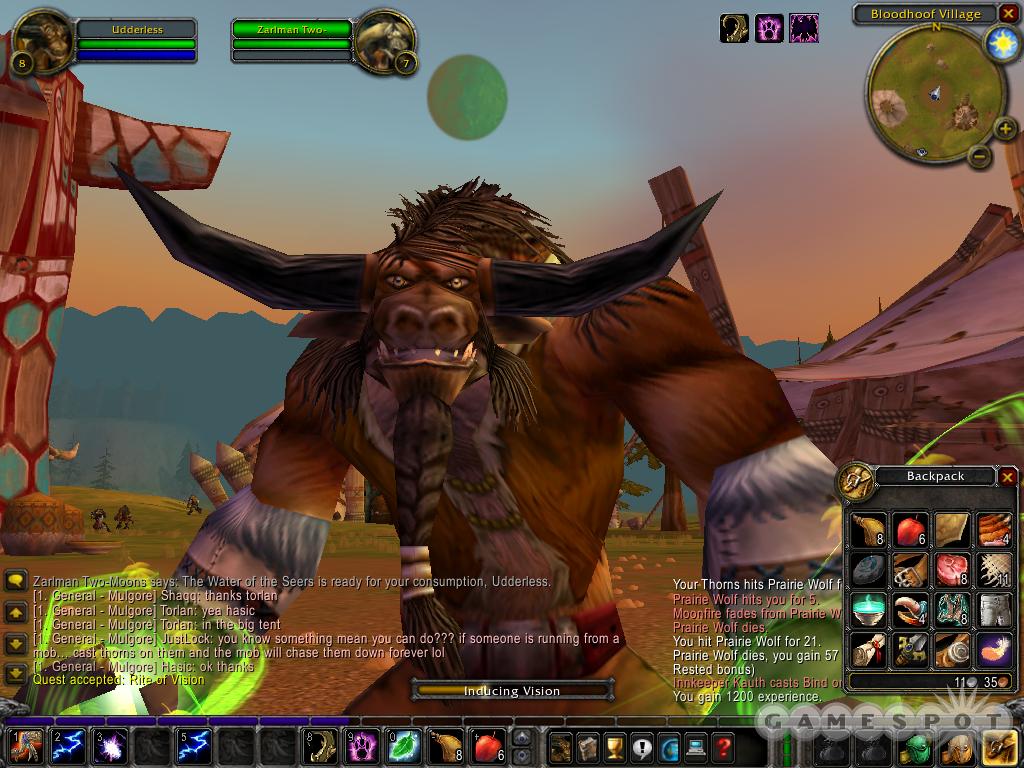
Join the conversation